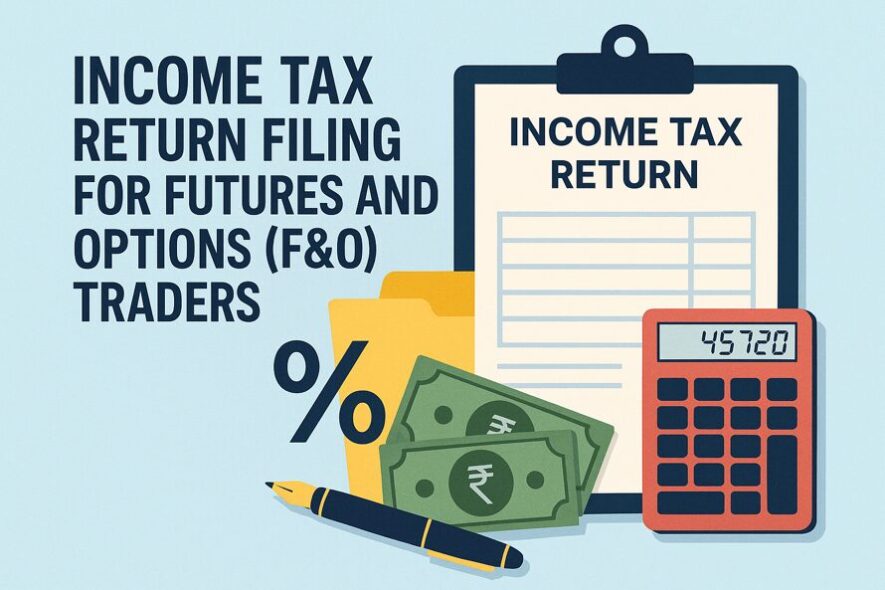
Introduction to F&O Trading and Income Tax
Futures and Options (F&O) trading is becoming popular among Indian traders. For example, on any given trading day, millions of Bank Nifty and Nifty contracts are executed. The rise of interest in F&O from retail, paired with the existing institutions, is phenomenal. Retailers and institutions use F&O trading to hedge their positions, speculate, or make quick profits. In fact, as with professional traders, options trading has become popular with regular salaried employees as well. With such massive activity, the tax department has sharpened its lens on F&O income.
If you trade F&O, filing taxes is unavoidable. The Income Tax Department considers F&O income as non-speculative business income. That changes everything, right from how you calculate turnover, to which ITR form you use, to whether you need an audit. Many new traders get confused because they compare F&O to stock delivery. But F&O taxation has its own rules, and understanding them is key to avoiding penalties and maximizing deductions.
This blog post breaks down Tax Return Filing for F&O into plain, step-by-step details. You’ll learn how to classify income, which form to file, what expenses you can claim, and how to manage losses.
Is Income from F&O Trading Taxable in India?
Yes. Income from F&O trading is fully taxable in India as per the Income Tax Act. Under this law, there is no difference between a full-time derivative trader and someone who trades in derivatives only occasionally. So it’s important to note that:
- Profits are taxed at your standard income tax slab rate (5%, 10%, 20%, or 30%).
- You can carry forward your losses and set them off against other income. Excess loss can be carried forward to the subsequent year.
- You can claim deductions for all related expenses like brokerage, internet, advisory, and electricity charges.
- GST does not apply to trading profits, but exchange transaction charges may attract GST, which is already included in brokerage bills.
For example, Neha trades Nifty options and earns ₹3,50,000 profit in FY 2024–25. She also has a ₹10,00,000 salary income. Her F&O profit is added to her salary and taxed at her applicable slab. If instead, she made a ₹2,00,000 loss, she can carry it forward to adjust against future non-speculative business profits.
Classification of F&O Trading under Income Tax Act
Business Income vs. Capital Gains
Unlike stock delivery, where you hold shares and pay capital gains tax, F&O trades are classified as business income under Section 28 of the IT Act. The government considers you as running a trading business. That means you prepare Profit & Loss accounts, maintain balance sheets (if required), and file under business income.
This classification also allows you to claim deductions on expenses. For instance, if you spent ₹1,20,000 on a trading workstation setup, you can claim depreciation on it because it supports your F&O business.
Speculative vs. Non-Speculative Business
The law categorizes business income into two types: speculative and non-speculative. Speculative income refers to trades settled without delivery (like intraday equity). But Section 43(5) of the IT Act clearly excludes F&O trades executed on recognized stock exchanges from being speculative. That means all your F&O profits or losses fall under non-speculative business income.
Why does this matter? Because speculative losses can only be set off against speculative profits, while non-speculative losses from F&O can be set off against almost all income types except salary.
Books of Accounts and Audit Requirements for F&O Traders
When Is a Tax Audit Mandatory?
A tax audit under Section 44AB kicks in when your turnover or profit reporting meets certain conditions. The triggers are:
- Turnover above ₹10 crore in a financial year with at least 95% of transactions being digital→ Audit mandatory.
- In other cases, the turnover threshold for audit is ₹2 crore
- If you prematurely exited the presumptive taxation scheme in the previous five financial years, regardless of the turnover threshold, an audit is mandatory.
Example: Ramesh trades F&O and records a turnover of ₹2.5 crore. His profits are just ₹2 lakh (less than 6% of turnover). Since profit is below the presumptive rate, he needs a tax audit under Section 44AB.
Section 44AB and Section 44AD Applicability
- 44AB governs mandatory audits for businesses above turnover limits.
- 44AD gives an option for presumptive taxation if turnover is below ₹3 crore (provided that your cash receipts during the year do not exceed 5% of the total turnover). Under this, you declare 6% of turnover as profit. No audit needed if you stick to this rule.
For example, Priya has a turnover of ₹90 lakh and opts for presumptive taxation. She simply declares ₹5.4 lakh (6%) as profit and pays tax accordingly. But if next year she wants to declare lower income, she’ll need an audit.
Turnover Calculation for F&O Trading
Turnover is not equal to contract value. ICAI has issued guidelines for calculating F&O turnover:
- Options Premium: Premium received on selling options is part of turnover.
- Absolute Profit: Add positive and negative differences of trades.
- Reverse Trades: Both legs are considered for turnover.
Example:
- Buy Nifty option at ₹200, sell at ₹250 → Profit ₹50.
- Buy another at ₹300, sell at ₹220 → Loss ₹80.
Turnover = ₹50 + ₹80 = ₹130 (absolute profit + loss).
If you sold options and received ₹2,00,000 premium, that also adds to turnover.
ITR Forms Applicable for F&O Traders
ITR-3 Form Overview
F&O traders must use ITR-3 because it covers income from business and profession. It allows:
- Profit & Loss reporting.
- Expense claims.
- Loss carry-forward entries.
- Multiple income sources (salary, house property, capital gains, etc.).
Cases Where ITR-4 Cannot Be Used
ITR-4 is for presumptive taxation under 44AD/44ADA/44AE. Serious F&O traders cannot use it because they need to declare actual profits and claim deductions. Only small traders with low turnover who want presumptive reporting can use ITR-4.
Filing Under the Presumptive Taxation Scheme
Under 44AD, traders with a turnover under ₹2 crore can declare 6% of their turnover as deemed profit. This avoids an audit. Example: If turnover is ₹50 lakh, you declare ₹3 lakh as income even if the actual profit was ₹1 lakh. Many traders avoid this route because it fixes the profit percentage regardless of the actual result.
Income Tax Filing Process for F&O Traders
Step-by-Step Guide to File ITR
- Collect broker statements – P&L, contract notes, and ledger.
- Calculate turnover using the ICAI method.
- Add expenses like brokerage, internet, electricity, and depreciation.
- Compute net profit or loss.
- Choose ITR-3 and fill in the business income schedule.
- Add other incomes (salary, FD interest, rent).
- Upload the audit report if the audit applies.
- Pay tax or claim a refund.
- E-verify return via Aadhaar, net banking, or DSC.
Reporting Losses and Carry Forward Rules
Losses in F&O are non-speculative. You can set them off against:
- Rental income.
- Interest income.
- Other business income.
Unadjusted loss can be carried forward for 8 years, but only if you file ITR before the due date.
Treatment of Expenses and Brokerage Charges
F&O trading is treated as a business. All genuine expenses are deductible:
- Brokerage and transaction charges.
- Advisory or subscription fees.
- Internet and electricity.
- Depreciation on a laptop or a desktop.
- Office rent (if used for trading).
Taxation on F&O Profits and Losses
How F&O Gains Are Taxed
Profits are added to your income and taxed at slab rates. Example: If salary = ₹8 lakh and F&O profit = ₹4 lakh, total taxable income = ₹12 lakh. Tax applies as per slabs.
Adjusting and Carrying Forward Losses
Suppose you made a ₹3 lakh F&O loss in FY 2024–25. You can adjust it against the rental income of ₹2 lakh. The remaining ₹1 lakh loss is carried forward for up to 8 years.
Set-Off Rules for Business Losses
- Non-speculative loss (F&O) can be set off against any income except salary.
- If not fully set off, carry forward to next year.
- Speculative loss (intraday equity) can only be set off against speculative gains.
Advance Tax and TDS Considerations for F&O Traders
F&O traders must pay advance tax if their liability exceeds ₹10,000. It’s paid in 4 instalments: June (15%), September (45%), December (75%), March (100%). Missing installments attract interest under Sections 234B and 234C.
Unlike salary income, there’s no TDS deducted on F&O profits. You must calculate and pay advance tax yourself.
Penalties for Non-Compliance and Late Filing
- Late filing fee: ₹5,000 if filed after the due date. But if your income is below 5 lakh, the late fees is ₹ 1,000.
- Audit not done: Penalty under Section 271B = 0.5% of turnover (max ₹1.5 lakh).
- Under-reporting income: Penalty = 50% of the tax evaded.
Common Mistakes F&O Traders Make in ITR Filing
- Treating F&O income as capital gains.
- Using the wrong turnover calculation.
- Skipping expense claims.
- Not paying advance tax.
- Filing ITR late, losing the loss carry-forward benefit.
- Ignoring the audit requirement when turnover/profit criteria are met.
Tools and Software for Easy Filing of F&O ITRs
- ClearTax and Quicko: Integrate with brokers and auto-import trades.
- CA tools like Winman ERP: Used by professionals for accuracy.
These save time and ensure compliance, especially when you have thousands of trades.
Conclusion
F&O trading in India is booming, but taxes can’t be ignored. The law sees F&O as business income, which means turnover calculation, expense deductions, and sometimes an audit. You must file your return under the correct ITR form and within the deadlines. If you don’t, you might attract penalties.
So if you are trading in futures and options, treat it like a business. It’s very important to maintain proper records and calculate turnover carefully. And during filing, make sure you are filing under ITR-3 with all the details. This will allow you to stay compliant, and you can claim deductions on expenses.
With the right approach, Tax Return Filing for F&O becomes less of a burden and more of a routine part of trading life.
FAQs:
Is an audit compulsory for F&O traders?
An audit is necessary if:
– Turnover above ₹10 crore in a financial year with at least 95% of transactions being digital→ Audit mandatory.
– In other cases, the turnover threshold for audit is ₹2 crore
– If you prematurely exited the presumptive taxation scheme in the previous five financial years, regardless of the turnover threshold, an audit is mandatory.
What is the best ITR form for F&O income?
The correct form is ITR-3, as F&O income is treated as non-speculative business income. ITR-4 can be used only if you opt for presumptive taxation under Section 44AD.
Can I carry forward F&O trading losses?
Yes. F&O losses are treated as non-speculative business losses. You can carry them forward for up to 8 years, provided you file your ITR before the due date.
How to calculate turnover in F&O trading for tax purposes?
Turnover is calculated as the sum of absolute profits and losses plus option premiums received. Both gains and losses are added without netting off. ICAI guidelines define the method.
Are F&O trades considered speculative?
No. F&O trades on recognized stock exchanges are classified as non-speculative business income under Section 43(5) of the Income Tax Act.
Can I claim expenses related to F&O trading in the ITR?
Yes. Brokerage, internet, advisory subscriptions, electricity, office rent, and even depreciation on computers used for trading can be claimed as business expenses.
What happens if I don’t file an ITR for F&O trades?
You may face penalties, lose the right to carry forward losses, and risk scrutiny from the Income Tax Department. Late filing can also attract fees under Section 234F.




